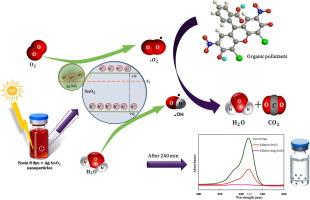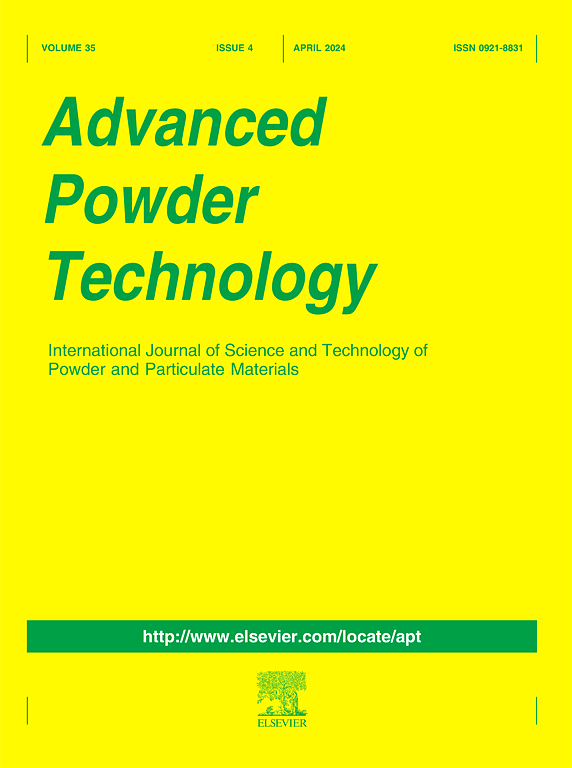基于中心复合设计的Ag-NPs修饰SnO2光催化降解伊红B的研究
IF 4.2
2区 工程技术
Q2 ENGINEERING, CHEMICAL
引用次数: 0
摘要
研究了合成的纯银纳米粒子(xAg-NPs)和修饰的氧化锡(SnO2)光催化降解伊红B的性能。采用紫外-可见分光光度计、XRD、TEM、FESEM、EDS和元素图对合成的纳米颗粒进行了表征。XRD分析证实,SnO2和Ag-SnO2纳米颗粒均具有晶体结构,平均尺寸分别为15 nm和13 nm。TEM图像显示,氧化锡纳米粒子的四边形形貌在Ag-NPs的修饰下变为球形。Ag-NPs修饰SnO2后,粒子的带隙从3.6 eV减小到3.4 eV。采用基于中心复合设计(CCD)的响应面法(RSM)对光催化过程进行了评价,并考虑了四个独立因素。考察了初始染料浓度(10 ~ 30 mg/l)、pH(4 ~ 10)、催化剂用量(40 ~ 200 mg)、照射时间(60 ~ 240 min)等操作变量,确定了光降解伊红b的最佳条件。工艺优化结果表明,当辐照时间为239.8 min, pH为6.74 mg,催化剂用量为185.6 mg,染料浓度为10.0 mg/l时,光催化降解效率最高,达到100%。降解反应符合一级动力学。本文章由计算机程序翻译,如有差异,请以英文原文为准。

Synthesis of Ag-NPs decorated SnO2 for enhanced photocatalytic degradation of Eosin B based on central composite design
The photocatalytic degradation performance of Eosin B using synthesized pure and silver nanoparticles (xAg-NPs) decorated tin dioxide (SnO2) were investigated. The synthesized nanoparticles were characterized using UV–Vis spectrophotometer, XRD, TEM, FESEM, EDS, and elemental mapping. XRD analysis confirmed that both SnO2 and Ag-SnO2 nanoparticles possess crystalline structures, with average sizes of 15 and 13 nm, respectively. TEM images revealed that the tetragonal morphology of SnO2 nanoparticles changed to spherical with Ag-NPs decoration. Furthermore, the band-gap of the particles decreased from 3.6 to 3.4 eV after decoration with Ag-NPs to SnO2. The photocatalytic process was evaluated using response surface methodology (RSM) based on central-composite design (CCD), considering four independent factors. Various operational variables, such as initial dye concentration (10–30 mg/l), pH (4–10), catalyst amount (40–200 mg), and irradiation time (60–240 min), were considered to identify the optimal conditions for the photodegradation of Eosin B. Analysis of variance (ANOVA) was applied to detect the influential factors and their significance levels. Process optimization revealed that the highest photocatalytic degradation efficiency of 100 % was obtained at an irradiation time, pH, catalyst amount, and dye concentration of 239.8 min, 6.74, 185.6 mg, and 10.0 mg/l, respectively. The degradation reactions corresponded well with first-order kinetics.
求助全文
通过发布文献求助,成功后即可免费获取论文全文。
去求助
来源期刊

Advanced Powder Technology
工程技术-工程:化工
CiteScore
9.50
自引率
7.70%
发文量
424
审稿时长
55 days
期刊介绍:
The aim of Advanced Powder Technology is to meet the demand for an international journal that integrates all aspects of science and technology research on powder and particulate materials. The journal fulfills this purpose by publishing original research papers, rapid communications, reviews, and translated articles by prominent researchers worldwide.
The editorial work of Advanced Powder Technology, which was founded as the International Journal of the Society of Powder Technology, Japan, is now shared by distinguished board members, who operate in a unique framework designed to respond to the increasing global demand for articles on not only powder and particles, but also on various materials produced from them.
Advanced Powder Technology covers various areas, but a discussion of powder and particles is required in articles. Topics include: Production of powder and particulate materials in gases and liquids(nanoparticles, fine ceramics, pharmaceuticals, novel functional materials, etc.); Aerosol and colloidal processing; Powder and particle characterization; Dynamics and phenomena; Calculation and simulation (CFD, DEM, Monte Carlo method, population balance, etc.); Measurement and control of powder processes; Particle modification; Comminution; Powder handling and operations (storage, transport, granulation, separation, fluidization, etc.)
 求助内容:
求助内容: 应助结果提醒方式:
应助结果提醒方式:


